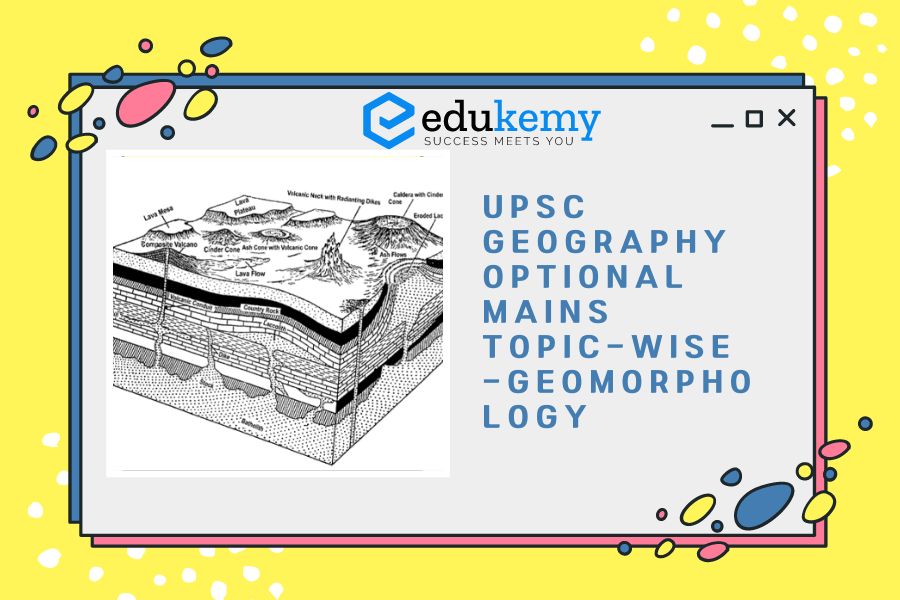
Delve into UPSC Geography Optional Mains Topic Wise Questions centered on Geomorphology. This meticulously curated collection provides a comprehensive exploration of landforms, processes, and their dynamic interactions, crucial for UPSC mains preparation. Each question is tailored to enhance conceptual understanding and analytical prowess, covering the intricate nuances of geomorphic phenomena. From erosion to tectonics, candidates gain insight into the geological forces shaping Earth’s surface, fostering a deeper appreciation of natural landscapes. With a structured approach and detailed explanations, this resource aids aspirants in mastering geomorphological principles, essential for excelling in the UPSC examination. Accessible yet thorough, it serves as an indispensable tool for aspirants navigating the complexities of geography optional.
Contents
- 1 Q1. Discuss with examples the influence of vulcanism and diastrophism on the evolution of landscape. (1993)
- 2 Q2. Define the concept of isostasy and discuss the postulations of Airy and Pratt. (2007)
- 3 Q3. Critically evaluate the continental drift hypothesis of A. Wegener. (2006)
- 4 Q4. Role of seismic waves in the study of earth’s interior: (2005)
- 5 Q5. “Structure is a dominant control factor in the evolution of landforms.” Discuss with suitable examples. (2005)
- 6 Q6. Describe the landforms which are products of endogenetic forces. (2004)
- 7 Q7. Explain the sequential development of landforms associated with the coastal areas. (2003)
- 8 Q8. Provide a critique of the ‘geographical cycle’ model propounded by Davis. (2002)
- 9 Q9. With reference to the theory of Plate Tectonics, explainthe origin and growth of the Young Fold Mountain Systems of the world. (2000)
- 10 Q10. Bring out the distinctions between the continental drift theory and the plate Tectonics theory. (1999)
- 11 Q11. Discuss the concept of volcanicity and show how the theory of plate tectonics explains the mechanism of volcanism and volcanic eruption. (1998)
- 12 Q12. Discuss the process of mechanical and chemical weathering and show their relationship with soil formation. (1996)
- 13 Q13. Discuss the limitations of the theory of Continental Drift and show how the theory of Plate Tectonics is an improvement over it. (1995)
- 14 In case you still have your doubts, contact us on 9811333901.
Q1. Discuss with examples the influence of vulcanism and diastrophism on the evolution of landscape. (1993)
Answer:
There are various geological processes, forces and resultant movements which are involved in the creation, destruction, recreation and maintenance of geomaterials and numerous types of relief features, and thereby in the evolution of landscape. Of these, Endogenetic Forces coming from within the earth introduce various types of vertical irregularities such as mountains, plateaus, plains, lakes, folds, faults, craters etc. Vulcanism and diastrophism are also the expressions of endogenetic forces which contribute significantly in the evolution of landscape.
Influence of Vulcanism: Vulcanism includes all those processes and mechanisms which are related to the origin of magmas and gases, there ascent and appearance on the earth’s surface in various forms. The topographic features produced by vulcanism or volcanicity can be grouped into two broad categories:
I.Extrusive Volcanic Topography
(i)From Explosive Type of Eruptions:
- Elevated forms, such as volcanic cones;
- Depressed forms, such as craters and calderas.
(ii)From Fissure Eruptions:
- Lava Plateaus and domes;
- Lava Plains.
II.Intrusive Volcanic Topography
- Istrusive lava domes and batholiths ;
- Lacoliths ;
- Phacoliths ; and
- Rills and dikes etc.
I.Extrusive Volcanic Topography:
(i)From Explosive Type of Eruptions
(a)Elevated Forms (Volcanic Cones): Explosive type of volcanic eruptions leads to the formation of several types of volcanic cones discussed below:
- Ash or Cinder Cones: They are built where eruptions have predominance of pyroclastic material, e.g. dusts and ashes. They don’t attain much height, hardly in excess of a few hundred metres. The slopes of cinder cones range between 300 and 45°. Typical examples are Mt. Jorullo of Mexico, Mt. Camiguin of Philippines etc.
- Composite or Strato Cones: These are formed by alternating sheets of lava and pyroclastic material and are height of all volcanic cones. Most of world’s large volcanoes belong to this category, e.g. Fujiyama (Japan), Cotopaxi (Ecuador), Mt. Sharta (USA) etc.
- Parasite Cones: In these, several branches of pipes come out from the main central pipe of the volcano and the cones are greatly enlarged.
- Acid Lava Cones: These high cones of steep slopes are formed by the highly viscous and silica-rich lava.
- Basic Lava Cones or Shield Cones: These long cones of low height are formed of light and less viscous lava with less quantity of silica.
- Basalt Domes: Hawaiian volcanoes are excellent examples of it formed by the extrusion of fluid basaltic lava. They often attain great heights.
(b)Depressed Forms: Under this group we study the volcanism in following manner:
- Craters: The funnel shaped depression surrounding the vent at the summit of a volcano is known as a crater. It is surrounded by very steep inward facing cliffs and may be several hundred metres in diameter and depth.
- Caldera: It is a very large crater which may arise by the coalescence of several small craters or by repeated explosions or by collapse. Crater lake, Oregon; Mt Katmai, Anaichak (Alaska) etc. are noted examples of caldera.
(ii)Extrusive Volcanic Topography from Fissure Eruptions
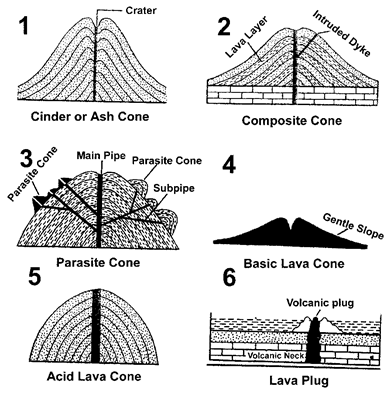
(a) Lava Plateaus: The Plateaus which are formed due to accumulation of thick layers of basaltic lava coming through the fissure eruption are called lava plateaus. Colombian plateau, Deccan Plateau, Yellow-stone plateaus of Wyoming, Drakensberg Plateau (S. Africa), Parana Plateau of Brazil, Uruguey and Argentina, etc are the typical examples.
(b)Lava Plains: These plains are formed due to deposition of thin sheets of lava coming out through fissure flows. Many of such plains are noticed in France, New Zealand, Iceland, USA etc.
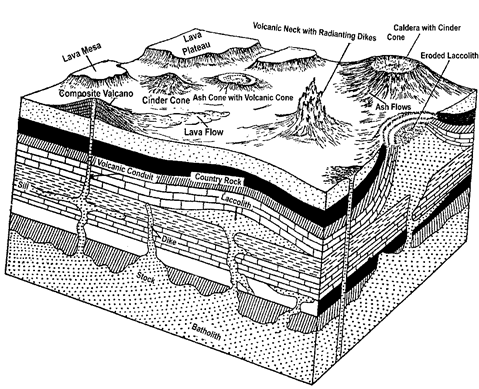
II.Intrusive Volcanic Topography: These volcanic features formed just below the earth’s surface are seen only when overlying country rocks are removed through prolonged erosion.
- Batholiths: These are large irregular and undulating mass of solidified magma with no observable bottom and very steep ride walls.
- Locolith: They are of mushroom shape having convex summital form.
- Phacoliths: They assume a wave like form of solidified magma.
- Lopoliths: They are bowl-shaped body solidified in a concave basin.
- Sills: Thick beds of magma parallel to the bedeling planes of rudimentary rocks are called rills.
- Dykes: These are wall-like formation of solidified magma perpendicular of the beds of rudimentary rocks.
Other landscape features associated with vulcanism are hot springs, geysers ( a special hot spring the intermittent spouting of water), Fumaroles ( smoke or gas emitting vents, e.g. Valley of ten thousand smokes, Katmai, Alaska), Solfatara (Fumaroles dominated by sulphur) etc.
Effects Of Diastrophism On Landscape Evolution: Diastrophism or diastrophic movements include both vertical and horizontal movements which operate very slowly, leading to the production of primary landforms. Primary landforms vary in size from continents, mountains, plateaus etc. to miniature fault scarps. These
diastrophic movements are of two types – (I) Epeirogenetic movements and (II) Orogenetic movements.
(I)Epeirogenetic Movements: Epeirogenetic movements (Greek : epeiros- land, continent) are vertical movements caused by radial forces and are characterised by large scale upliftment, subsidence or submergence and emergence of land areas. The movements involved are so slow and widespread that no obvious fracturing or folding is produced in the rock.
Every continent including Antarctica offers unmistakable evidence of both downward and upward movements since Precambrian. Much of the northern coast of Gulf of Mexico has been subsiding very slowly for many centuries. Many islands near the coast of British Columbia are believed to have been part of mainland relatively recently. According to an estimate, major parts of Scandinavia and Finland have risen by 900 feet.
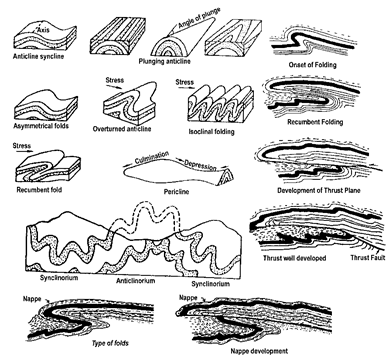
II.Orogenetic Movements: Orogenetic movements (Greek: oros-mountain) are caused due to endogenetic forces working in horizontal manner (tangential forces). These movements relate to behaviour of plate margins and involve intense folding, faulting, thrusting and uplift of narrow belts. Such movements can be divided into: (i) Compressional and (ii) Tensional movements.
(i)Compressional Movements: The force when operates face to face is called compressional force. Such forces or movements lead to the formation of various types of folds such as:
- Anticline,
- Syncline,
- Monocline fold,
- Arymmetrical fold,
- Overturned fold,
- Isoclinal fold,
- Recumbent fold, and
- Nappe
Such folds and nappe structures are found extensively in the fold mountain areas.
(ii)Tensional Movements: Movements operating in opposite direction are tensional movements. Various types of fault topography produced by such movements such as:
- Normal Fault: Displacement of both the rock blocks inopposite direction.
- Reverse Fault: Movements of both the fractured limbs towards each other. Such thrust fault are common in highly folded areas such as Alps.
- Lateral or Strike-Slip Fault: Rock blocks are displaced horizontally.
- Hinge Faults: These are produced by rotational movement.
- Step Faults:Series of faults having slopes in the same direction.
- Block mountains (Horst): They represent the upstanding part of the ground between two faults or on either side of a rift valley. Noted examples are Sierra Nevada mountain of California (considered to be the world’s most extensive block mountain), Wasatch Range (USA), Vosges and Black Forest mountains bordering Rhine Rift Valley etc.
- Rift Valley (Graben): Rift valley represents a trough, depression or basin between two crustal parts and are formed by faulting activity. Striking examples include Rhine Rift Valley, Great Rift Valley of Africa, Death Valley, Dead Sea, Spencer Gulf etc.
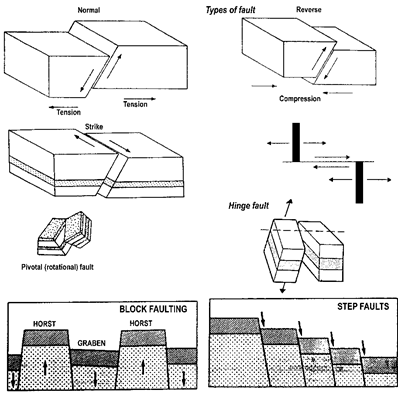
Q2. Define the concept of isostasy and discuss the postulations of Airy and Pratt. (2007)
Answer:
The theory of isostasy postulates a system for the distribution of material in the earth’s crust which conforms to and explains the observed gravity values. This theory was developed from gravity surveys in the mountains of India around 1850s. The results show that the actual force of gravity over the mountain range is considerably less than what it should be theoretically.
The concept of isostasy means that a state of equilibrium or balance exists in the Earth’s crust. Moho discontinuity, the boundary between the crust and mantle, is found deepest beneath large mountain ranges and shallower beneath regions of lower surface elevations. For example, the Moho’s discontinuity is 80 km. deep beneath mountain ranges, 40 km. beneath the continental regions and only 6 km. beneath the ocean bottom.
This means that the lithosphere is floating on the asthenosphere with more massive portions reaching deeper to obtain needed buoyancy. a massive block of ice extends deeper into the water than a small ice cube and the top side will project into the air proportionately. If several blocks of wood of the same cross section but of differing height are floating in a water tank, each of the different blocks rises itself above the water level by an amount, which is proportional to its length. A series of such blocks are in a state of hydrostatic equilibrium. Likewise, differences in density may also be responsible for such hydrostatic balance. Lighter density materials have a tendency to rise high.
Thus, mountains which are composed of lighter materials than the surrounding lowlands are high. Loss of material and thus, weight by denudation of a landmass will upset the equilibrium of the landmass and causes it to rise until equilibrium is reached. If any additional weight is added to the landmass, such as a pile of volcanic material on the oceanic crust, it can make the crust subside. accumulation of ice will also tend to depress the landmass. This process must involve some compensatory lateral flow of material at depth in the mantle, i.e. there must be lateral flow from beneath the sinking column towards the rising column.
Airy’s View: Airy postulated that there is a change in the density of rocks at depth in the earth’s interior and that the upper lighter material floats on the more dense part, which behaves like a fluid. The depth of this change varies from place to place. Under mountains, the depth is greater than that under oceans or plains.
In other words, the mountains have roots of light-weight materials which extends down into the lower, more dense mantle rocks. The lower density of the roots causes the observed gravity values measured in the mountain ranges to be lower than predicted theoretically.
Pratt’s View: Pratt’s theory differs from Airy’s in that Pratt assumed that the boundary between the upper light material and the lower dense rocks is at a uniform depth, called the depth of compensation. He further assumed that,there are variations in the density of the lighter layer, and are related to the elevation of the surface. Lighter material lies under mountains and heavier material under oceans. The weight of columns of rocks extending from the surface to the depth of compensation in different parts of the earth is thus the same.
Gravitational studies offer no means of determining which of these theories is more nearly correct. It is possible that neither is absolutely correct but evidence from other geological studies suggest that Pratt’s theory comes closer to fitting all the facts that we have. Seismic studies,indicate that more dense material underlies ocean basins than continents. These observations support Pratt’s view of a connection between density and elevation.
Heiskanen’s View: Airy postulated that columns of rocks are nearly the same in density, floating like blocks in a fluid. Pratt suggested that different segments of the earth are of different densities, but these differences are compensated at a certain depth. A third hypothesis has been formulated by Heiskanen. He combines the views of both Airy and Pratt. It has been observed that rocks at sea level are more dense on the average than those of higher elevation (2.76 grams per cubic cm. at sea level down to 2.70 gm. per cubic cm. at elevations in high mountains). He assumed that, this change continues downward, tending to make deeper rocks more dense than shallower ones in all sections of the earth’s crust. In addition, different sections are thought to have different densities and different lengths.
Heiskanen’s theory has the advantages of being based on actual knowledge of density variations that can be obtained by direct measurement and when it is applied to the observations that we now have on the gravitational field, it yields very low anomalies.
On the basis of isostacy, many conclusions are drawn. If we suppose that, the height of Mount Everest is 9,000 metres, the lower end of Mount Everest be 9 inches deep in the substratum, i.e. about 81,000 metres deep. Again the process of compensation does not take place swifty. Compensation takes place slowly, because isostacy is disturbed in a large area. There is no evidence that any large area ever rises or subsides by 100 or even by 5 metres as a result of the process of compensation. Compensation is a very slow process. For example, the Gulf of Bothnia is rising every year by one cm. During the Ice-ages, Scandinavia, North America, etc. became heavy on account of thick layers of ice and consequently sank into substratum. On account of the onset of warm age, the ice melted and these areas became light again and are now rising slowly. Hence, compensation takes place in large areas. The activity is not local but regional.
Q3. Critically evaluate the continental drift hypothesis of A. Wegener. (2006)
Answer: The drifing of continents was first suggested by the French scholar Antonio Snider in 1858, but this was so much opposed to the scientific view that nobody took notice of it.
In 1910, F.B. Taylor of America invoked the hypothesis of horizontal displacement or continental drift with a view to explain the distribution of mountain ranges, but due to various reasons the hypothesis of Taylor received scant attention. German professor Alfred Wegener was the first to present in a lecture his idea that earth’s landmasses migrate. His book, ‘Origin of Continents and Oceans’ appeared in 1915. Wegener is regarded as the father of this concept, basing his theory not only on the shapes of the continent, but also on geological evidences such as similarities in the fossils found in Brazil and Africa.
Wegener through a series of maps showed
three stages in the drifting process, beginning with an original large landmass, which he called ‘Pangaea’ (meaning “all lands”). Wegener believed that the continents composed of light-silic rocks plowed through the denser rocks of the oceans floor driven by forces related to the earth.
Wegener was drawn to the idea to explainthe ancient climates of the past. The climatic changes on the earth could be explained in two ways:
- Either the continents remained stationary at their places and climatic zones shifted from one region to another or
- The climatic zones remained stationary while the landmasses were displaced and drifted.
Wegener collected evidences in support of his view that continents drift and gave following proofs:
Pangaea: Pangaea (Pan = all+gaea = earth) is a hypothetical continent from which the present continents originated by drift since the Carboniferous period till the present. According to Wegener’s hypothesis, Pangaea broke up to form (i) Laurasia (North America, Greenland, and Eurasia north of Indian sub-continent) and (ii) Gondwanaland (South America, Africa, Madagascar, India, Arabia, Malaysia, East- Indies, Australia and Antarctica). These two blocks were separated by a long shallow sea, called the ‘Tethys Sea’.
The pangaea was surrounded on all sides by anextensive water mass called the Panthalassa (pan=all + thalass = oceans). Wegener also assumed that in the Carboniferous period the South Pole was near Natal (South African coast) and North Pole was near the Pacific Ocean.
Wegener is also of the opinion that the continents are made of Sial and the ocean basins are made of Sima. according to him, Sial being lighter is floating over the denser Sima freely.
Direction of Drift: Wegener opines that the continents drifted in two directions: towards the equator, and towards the west. during the equatorward drift, Africa and Eurasia, were pushed closer together and the Tethys Sea deposits, located in between the two, were raised up in the form of mighty folded mountains of Alps, Atlas, Himalayas etc. The peninsula of India and Africa were separated from Antarctica and Australia due to equatorward drift.
The westward movement was due to the tidal forces of the moon and the sun on the continents. During this westward drift, North America and South America got separated from Europe and Africa and Atlantic Ocean came into existence. Evidences in support of the Continental Drift: Wegener in support of his theory gathered geomorphological, climatological and paleontological evidences. Some of the evidences given in support of the theory are:
- The geographical similarity in the opposing coasts of the Atlantic Oceans.
- The eastern coast of South America can be fitted against the western coast of Africa. This was called the ‘jig saw – fit’ of the opposing coasts of Atlantic ocean.
- Palaeontological Evidence: The striking similarity of certain fossils found on the continents on both sides of the Atlantic ocean. Fossils of glossopteries, a fern – like plant, have been found in rocks of the same age from South America, South Africa, India and Australia and within 480 km of the South Pole in Anarctica. Mature seeds of this plant were several millimetres in diameter, too large to have been dispersed cross the ocean by winds. The simultaneous presence of glossopteries can be seen on all of the southern continents. Therefore, it is a strong supporting evidence that the continents were once connected. The distribution of paleozoic and mesozioc reptiles provides similar evidence as fossil’s several species have been found in the now- separated southern continents.
- Evidence from Structure and Rock Type: A number of geological features end abruptly at the coast of one continent and reappear on the opposite continent across the Atlantic Ocean. The folded mountain ranges at the Cape of Good Hope at the southern tip of Africa and structure of same age and style of deformation appear near Buenos Aires in Argentina. The Applachians of the north-eastern regions of North America are compatible with the mountain system of Ireland, Wales and North- Western Europe.
- Evidence from Glaciation: In the paleozoic era (about 300 million years ago) glaciersal covered large portion of the continents in the Southern Hemisphere. Except for Antarctica, all the continents in the Southern Hemisphere have no trace of glaciation during this time.
- Evidence from other Palaeoclimatic Records: Evidence of striking climatic changes recorded in the stratigraphic record tends to support the drift theory. Great coal deposits in Antarctica show that abundant plant life once flourished on that continent which is now covered with ice. On the other continent, salt deposits, formation of windblown, sandstone, and coral reefs provide additional clues us to reconstruct the climatic zone of the past.
- Palaeomagnetic Evidence: There have been changes in the positions of the poles in different geological periods which Wegener has called ‘polar wandering’. The palaeomagnetic data reliably indicates the existence of pangea at the end of the palaeozoie era.
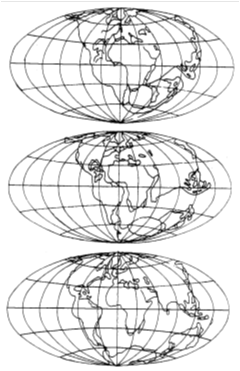
Criticism of Wegener’s Theory: It is clear that Wegener had amassed an imposing array of evidences in support of his theory and some of these evidences were undeniably convincing. However, the theory was based on so much speculation and inadequate evidences that it provoked a lot of criticism and controversy and people were not inclined to accept his views.
- The great criticism of Wegener was the tidal force which was hopelessly inadequate to cause drift. The westward drift of the continents was ascribed by Wegener to the tidal force of the moon and the sun, but this movement is only possible when the tidal force is ten thousand million times more than at present, and if the tidal force really increased to this dimension, then it would have stopped the rotation of the earth within one year. If there are clear evidences of drifft, then the inability to point to a force which would have caused it cannot be considered a genuine criticism of the theory.
- The second objection raised against the theory was that the Rockies and the Andes mountain system could not have been formed in the manner envisaged by Wegener, because if the Sial was floating over the Sima, then the Sima could not offer so much resistance to westward movement of the continents as to cause folds and build mountian systems.
- The third objection was that jig-saw fit of the opposing coasts of the Atlantic ocean on which so much stress was laid, was not complete.
- To expect that after the breaking and drift of the continents there would be an exact-fit of the opposing coasts of Atlantic is unnatural.
- Fourth objection was closely related to the third. Although there was similarity in the structural and stratigraphical features of the two coasts of the Atlantic, it would not be quite correct to conclude that it was an extension of the other and that they were joined together.
- Contrasting views regarding sial and Sima: Initially he says that Sialic continents are floatingfreely on the Sima but later he uses the concept of resistance offered by Sima to explain the mountain building process.
It is true that Wegener presented his case more like an advocate than like a scientist, emphasizing the evidence in his support and ignoring those which went against his theory.
Q4. Role of seismic waves in the study of earth’s interior: (2005)
Answer:
Seismology is the only reliable source which gives reliable knowledge about the interior of the earth.
There are three types of seismic wave:
- Primary waves or P Waves: P waves are the longitudanal waves which travel fastest through the solid material. They can pass through liquid but their speed slows down in it.
- Secondary waves or S Waves: S waves are the transverse waves which cannot pass through liquid.
- Surface waves or L Waves: These wave cover the longest distance of all the seismic waves.
Seismic waves passing through the earth are refracted at points of distinct discontinuities within earth’s interior and provide the basis for the belief that earth has
- a soild core
- a liquid outer core
- a soft asthenosphere
- a rigid lithosphere
For an earthquake at a particular spot (labelled 0°) the shadow zone for ‘P waves’ invariably exists between 103 and 143 degrees from the focus of the earthquake. Evidently, something deflects the waves from a linear path.
The best explanation for this shadow zone is that earth has a core through which ‘P waves’ travel relatively slowly. Seismic rays through the mantle follow a curved path from the earthquake.
It the Earth would have been composed of homogenous material, the seismic waves should have reached
the core of the earth in a straight path but this is not the case. Earth is not composed of homogenous material. ‘S’ waves disappear at an angle of 120° from the epicentre. ‘S’ waves are totally absent from the core of the earth. Thus, the core is liquid at a depth of 2900 km from the Earth surface. It is made of iron + nickel.
Earth Crust: (6 to 48 km)Si + al (Sial) average density 2.9, depth 50 km to 300 km.
Ocean Basin – Sima (Si + Ma), Density 2.9 to 4.7, depth 1000 to 2000 km.
The Mantle: Density 5.7, composed of dense rigid rocks. The mantle may be divided into two parts (1) the lower mantle or the Mesosphere and (ii) the upper mantle or the Asthenosphere.
The velocity of the earthquake waves decreases in Asthenosphere.
Core: Nife = (Ni + Fe), density : 9.5 – 12.3 g/cm3
the diametre of core = 6880 km.
Q5. “Structure is a dominant control factor in the evolution of landforms.” Discuss with suitable examples. (2005)
Answer:
The given statement represents the geographical cycle of Davis. The gist of the cyclic concept is that commencing with an initial landscape, generally assumed to be one of low relief, the land surface passes through an orderly sequence of forms and eventually returns to a surface of low relief.
views that in order to understand the evolution of a particular land form/landscape, it is extremely important to know the stages of development were influenced by Davis. But the process of sculpture, geological structure and nature of rocks also exerts an important influence on the fashioning of the landscape.
Keeping the above facts in mind Davis states that landscape is a function of structure, process and stage. These are three principal controlling factors in the evolution of any land scape, as it passes from an initial stage via sequential forms to penultimate state.
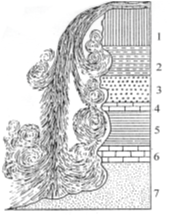
Structure: The word structure has been used in the larger sense and includes not only regional geological structure, folds, faults and such other broad features but also thenature of rocks and their characteristics their physical and chemical properties, their permeability and solubility, the nature of joints etc.
Thus on a very permeable rock, there will be minimum run off and so erosion by running water will be slower than on an adjacant impermeable rock. Soft rock slabs erode more readily than massive quartrite. As a rule, the influence of rocks on landscape is quite marked, however, sometimes the influence of structure is so pervasive and uniform over a relatively large area that this is not apparent from the landscape. The structure, as a rule, is other than the landscape, and provides the base for the operation of the various gradational processes, which give rise to new sequential land forms.
In the evolution of landforms, Davis has identified three stages. These stages of erosion are:
- youth
- mature
- old.
Just as each process gives rise to distinctive landscape; so also each stage or the erosion cycle is characterised by distinctive land forms with the help of which it is possible to identify the stage of evolution of landscape. There is a direct relationship between the stage of development and the character of landforms. Thestage of development of landforms, however, do not have equal life span. The gorges, v-shaped valleys; waterfalls, rapids and steep spur are the characteristics of youth stage.That is directly related with structure. Zeugen and Yardang, Cirques and Roches Moutonnes, Arch and stack are other landforms directly related with structure.
Gorges are formed due to active down cutting of the valleys through the mechanism of pothole drilling during juvenilestage of the fluvial cycle of erosion. Gorges are also formed due to recession of water falls. Most of the Himalayan rivers have carved out deep and narrow gorges. Water falls or simply falls are caused because of sudden descent or abrupt breaks in the longitudinal course of the rivers due to a host of factors; i.e., variation in the relative resistance of rocks, relative difference in topographic reliefs, fall in the sea level and related rejuvenation, earth movement etc. Normal water falls include those falls which are formed due to variation in the resistance of rocks.
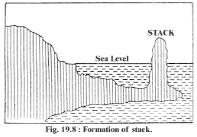
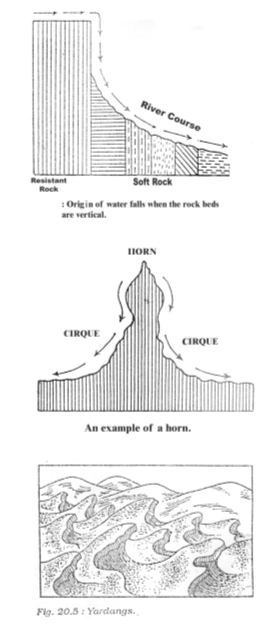
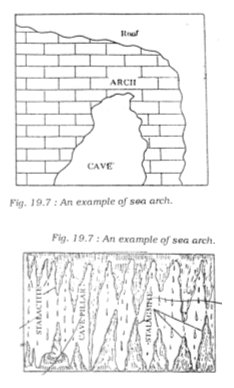
Zeugen and Yardang are aeolian land forms. Rock masses of tabular form resembling a cappedinkpot standing on softer rock pedestal of shale, mudstone etc, are called Zeugen. The bases of such features are broader than their tops. These are formed in those desert areas where temperature during night becomes so low that the moisture in the joints and crevices of rocks freezes. yardangs are steep-sided deeply undercut overhanging rock ridges separated from one another by long. grooves or corridors or passageways cut in desert floors of relatively softer rocks.
In glaciated topograply; the armchair-shaped circque is a horseshoe- shaped, steep walled depression representing a glaciated valley head. Roches mountonnes are streanlined asymmetrical hillocks, mounds or hill having one side smoothly moulded with gentle slope. Nunatak, Horn, Crag are other examples.
Steep rocky coast rising almost vertically above sea water is called seacliff which is very precibitous with over hanging crest. The steepness of true vertical cliffs depends on variations of lithology and geological structure. Cave, arch, are other examples.
Karst topography fully related with structure. In area of limestone and dolmite rocks the solution action of under ground water gives rise to highly distinctive landforms both on and below the surface which are collectively known as karst landforms.
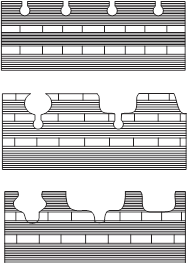
However, geological structure is not always the only dominant controlling factor in the evolution of landforms. Sometimes exogenetic (denudation) processes become so effective and dominant that they overshadow the control of geological structure and makes it a passive factor in the evolution of landforms. The landforms cannot be ascribed to one cause but are the product of complex interplay of several factors and processes, both endogenetic (rock structure etc) as well as exogenetic (originating from the atmosphere and including weathering, transportation and erosion).
Q6. Describe the landforms which are products of endogenetic forces. (2004)
Answer:
There are various geological processes, forces and resultant movements which are involved in the creation, destruction, recreation and maintenance of geomaterials and numerous types of relief features. These forces are divided into two broad categories—Endogenetic Forces and Exogenetic Forces. Endogenetic forces refers to the forces coming from within the earth.
The interation of matter and temperature generates endogenetic forces or movements inside the earth. These forces introduce/produce various types of vertical irregularities and land forms such as mountains, plateaus, plains, lakes, folds, faults, craters, etc. The endogenetic forces and movements are divided into two major categories viz. 1. Diastrophic Forces and ; 2. Sudden Forces.
1.Diastrophic Forces and Resultant Landforms: Diastrophic forces or movements include both vertical and horizontal movements which operate very slowly, leading to the production of primary landforms. Primary landforms vary in size from continents, mountains, plataus, etc. to miniature fault scarps. These diastrophic forces are of two types: (a) Epeirogenetic Forces and; (b) Orogenetic Forces.
(a) Epeirogenetic Forces: Epeirogenetic forces (Greek: epiros-land, continent) are vertical forces caused by radial forces and are characterized by large scale upliftment subsidence or submergence and emergence of land areas. The forces involved are so slow and widespread that no obvious fracturing or folding is produced in the rock.
Every continent including Antarctica offers unmistable evidence of both downward and upward movements since precambrian. Much of the northern coast of Gulf of Mexico has been subsiding very slowly. Many islands have been formed by such movements near the coast of British Columbia. An estimate puts parts of Scandinavia elevated by 900 feet. Many places which were on the sea some centuries ago are now few miles were on the sea some centuries ago are now few miles inland in India, e.g. Coringa (Godavari), Kaveripattnam, etc.
(b)Orogenetic Forces: Orogenetic forces (Greek: Orosmountain) are caused due to endogenetic forces working in horizontal manner (tangential forces). There movements relate to behaviour of plate margins and involve intense folding, faulting, thrusting and uplift of narrow belts. Orogenetic forces can be divided into: (i) Compressional and (ii) Tentional Forces.
(i).Compressional Forces: The forces which operate face to face are called compressional forces. Such forces or movements leads to the formation of various types of folds such as:
- Anticline: The upfolded rock beds.
- Syncline: The downfolded rock beds
- Asymmetrical folds: One limb inclines moderately, other limb at right angle.
- Monoclinal folds: One limb inclines moderately, other limb at right angle.
- Isoclinal fold: Both limbs become parallel but not horizontal.
- Recumbent fold: Both lims become parallel as well as horizontal.
- Overturned fold: One limb is thrust upon another.
- Nappe: One limb of the recumbent folds overrides the other fold after breaking and sliding forward.
Such folds and nappe structures are forces caused chiefly by the plate movements help in the formation of fold mountains a gigantic landform on the earth.
2.Tentional Movements/Forces: Movements operating in opposite directions are tensional movements. Various types of landforms are produced by such forces such as:
- Normal Fault: Displacement of both the rock blocks in opposite direction.
- Reverse Fault: Movement of both the fractured limbs towards each other. Some sort of compression is also involved in such thrust faults.
- Strike-slip Fault: Rock blocks are displaced horizontly.
- Hinge Faults: Are produced by rotational movement.
- Step Faults: Series of faults having slopes in the same direction.
- Block Mountains (Horst): They represent the upstanding part of the ground between two faults or on either side of a rift valley. Noted examples are Sieroca Neveda mt. of California, Wasatch Rangnen (USA), etc.
- Rift Valley (Graben): Rift valley represents a trough or depression between two crustal parts and are formed by faulting activity. Striking examples include Rhine rift valley, Great Rift Valley of Africa, Death Valley, Dead Sea, Spencer Gulf, etc.
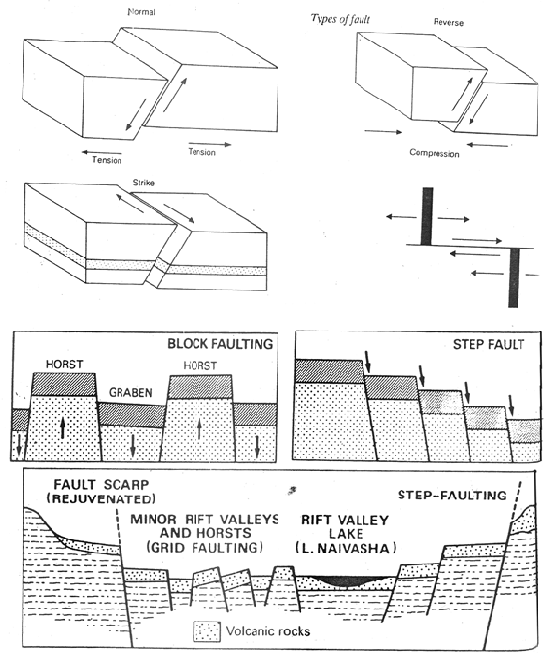
8.Sudden Forces: Sudden movements caused by sudden endogenetic forces work very quickly and their effects are seen almost instantly. However, there forces are the result of long-period of preparation deep within the earth. There hazardous events such as Volcanism and Earthquakes produce various type of landforms. Earthquakes create faults, fractures etc. which has already been discussed. Landforms produced by volcanicity are being discussed here.
- Landforms Produced by Volcanicity: All the process and mechanisms related to the origin and ascent of magma and gases on the earth’s surface in various forms comes under volcanicity. The topographic features produced by volcanic forces can be grouped into two broad categories:
I.Extrusive Volcanic Topography
(i)From Explosive type of Eruptions
(a)Elevated Forms (Volcanic Cones): Explosive type of volcanic cones discussed below:
- Ash or cinder cones are built where eruptions have predominance of dusts and ashes. They are of low height and their slopes range between 30° and 45°. Typical examples are Mt. Jorullo of Mexico, Mt. Camiguin of Phillippines, etc.
- Composite or Strato Cones are formed by alternating sheets of lava and pyroclastic material and are heighest of all volcanic cones. Most of world’s large volcanoes belong to this category, e.g. Fujiyama Cotopaxi (Ecuador), Mt. Shastra (USA), etc.
- Parasite Cones: In these several branches of pipes come out from the main central pipe of volcano and the cones are greatly enlarged.
- Acid Lava Cones: These high cones of steep slopes are formed by the highly viscous and silica rich lava.
- Basic lava cones or shiel cones: These long cones of low height are formed of less viscous lava with less quantity of silica.
- Basalt domes: Hawaiian volcanoes are excellent examples of it formed by the extrusion of fluid basaltic lava.
(b)Depressed Forms
- Craters: The funnel shaped depressions surrounding the vent at the summit of a volcano is called crater. It is surrounded by very steep inward facing cliffs.
- Caldera: A large crater is called Caldera which may arise by the coalescence of many small craters or by repeated explosions or by collapse. Noted examples are Crater-lake, Oregaon; Mt. Katmai (Alaska).
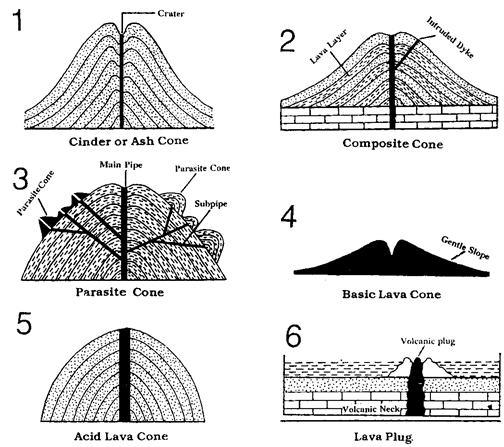
(ii)Extrusive Volcanic Topography from Fissure Eruptions
(a)Lava Pleateaus: The plateaus which are formed due to accumulation of thick layers of basaltic lava coming through the fissure eruptions are called Lava Plateaus. Combian Plateau; Deccan Plateau, Yellow-stone Plateau of Wyoming; Drakensberg Plateau, Parana Plateau of Brazil, Uruguay and Argentina; etc.
(b)Lava Plains: These plains are formed due to deposition of thin sheets of lava coming out through fissure flows. Many of such plains are noticed in France, New Zealand, Iceland, USA etc.
II.Intrusive Volcanic Topography: These volcanic features formed just below the earth’s surface are seen only when overlying country rocks are removed through prolonged erosion.
- Batholiths: These are large, irregular and undulating mass of solidified magma with no observable bottom and very steep side walls.
- Lacoliths: They are of mushroom shape having convex summital form.
- Phacoliths: They assume a wave like form of solidified magma.
- Lopolithis: They are bowl shaped body solidified in a cancave basin.
- Sills: Thick beds of magma parallel to the bedding planes of sedimentary rocks are called sills.
- Dykes: There are wall like formationof solidified magma perpendicular to the beds of sedimentary rocks.
Other landscape features associated with volcanicity are hot springs, Geysers (a special hot spring with intermittent spouting of water), fumaroles (smoke or gas emitting vents, e.g. Valley of Ten Thousand Smokes, Katmai (Alaska), Solfatara (fumaroles dominated by sulphur), etc.
Q7. Explain the sequential development of landforms associated with the coastal areas. (2003)
Answer:
The theoretical cycle of marine erosion suggests that shoreline development follows a sequential order in which characteristic land forms are formed in different stages. In the initial stage most coasts are irregular but the normal tendency of marine erosion is to make the coasts regular in course of time. Hence initially erosional land forms are formed. After a period of time, the formation of depositional features start taking place. The depositional process dominates in the later stage of shoreline development.
Following this sequence, the development of erosional landforms is being explained first here:
- Erosional Landforms: Two major landforms produced by marine erosion are the sea cliffs and the wave cut benches or platforms. In addition, there are some smaller but striking features related to these, such as notch, cave, arch, stack etc.
- Sea Cliffs: Steep rocky coast rising almost vertically above sea water is called sea cliff which is very precipitous with overhanging crest. When the waves first start their work of erosion on a sloping land mass, they cut a small nick or notch. This is the starting point of the formation of the sea cliffs involving the erosion of coastal rocks through the mechanism of hydraulic actions and abrasion by breaker waves (swash or surf currents). This notch is cut at the base of the slope. There is gradual extension of notch landwards due to continuous wave attack with the result that the crest of the cliff overhangs the notch. If the process is continued, the overhanging head of the cliff breaks and falls down resulting into gradual recession of the cliffs landward. The height of the cliff goes on increasing with the continued erosion of the coast, and below it the width of the wave cut platform also goes on increasing simultaneously. The rate of cliff recession varies both in space and time depending on the following conditions:
- Rock lithology and structure
- Susceptibility to chemical erosion & mass movement
- Cliff height
- Orientation of the coast
- Wave energy
The given figure shows the different types of cliffs on the basis of their morphology:
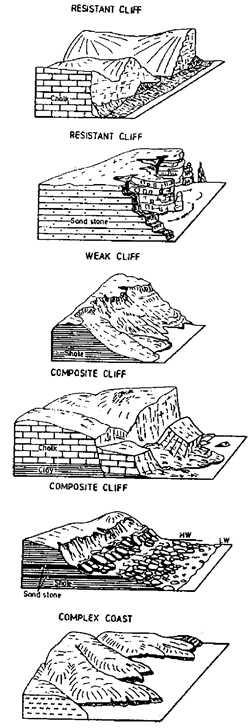
Wave Cut Platform: Rock cut flat surfaces in form of cliffs are called wave cut platforms which are slightly concave upward. The origin and development of wave cut platforms is related to cliff recession. Quarrying and plucking by large and high energy storm waves and water level weathering are effective marine processes of shore platform development. Thinly bedded and densely jointed rocks with strike parallel to the coastline are vigorously eroded by uprushing breaker waves and thus are associated with extensive wave cut platforms. Following figures clearly depicts the formation of cliffs and wave cut platforms:
(1)
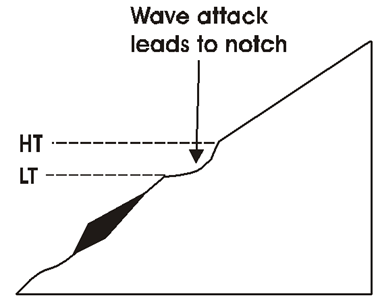
(2)
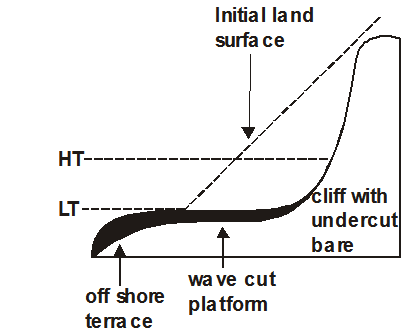
Capes and Bays: On exposed coasts, the continued action of waves on rocks of varying resistance causes the coastline to be eroded irregularly. This is particularly pronounced where hard rocks, e.g. granites and limestones, occur in alternate bands with softer rocks e.g. sand and clay. The softer rocks are worn back into inlets, coves or bays and the harder ones persist as headlands promontories or capes.
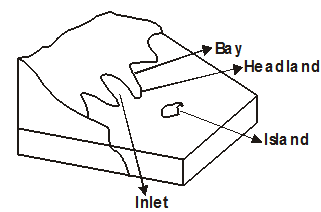
Cave, Arch, Stack and Stump: Prolonged wave attack on the base of the cliff excavates holes in regions of local weakness called caves. When two caves approach one another from either side of a headland and unite they form an arch. Further erosion by waves will ultimately lead to the total collapse of the arch. The seaward portion of the headland will remain as a pillar of rock, known as stack. Further erosion will leave only the stumps which are only just visible above the sea level.
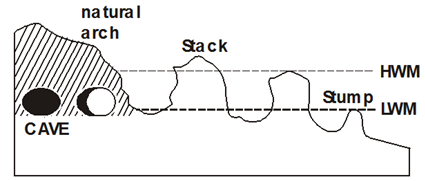
Geos and Gloups: The occasional splashing of the waves against the roof of a cave may enlarge the joints when compressed air is trapped inside. A natural shaft is thus formed which may eventually pierce through the surface. Such a shaft is termed a gloup. Due to enlargement of holes and continued action of waves, the roof collapses and a long, narrow inlet or creek develops.
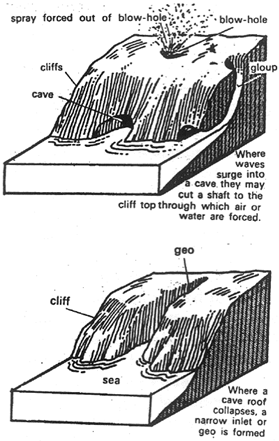
Depositional Land Forms: In the late youth stage, the depositional features are more common. Even in early youth beaches are formed in the back shore zone.
Beaches: Sands and gravels loosened from the land are moved by waves to be deposited along the shore as beaches. This is the most dominant form of the constructive work of the sea. Beaches are deposited by breaker waves between high and low tide waters. Beaches are generally formed when sea is calm and winds are of low velocity. The coarser materials (cobbles and boudlers) are dropped by the waves at the top of the beach. The fixer materials (pebbles and sand grains) which are carried down the beach by the backwash are dropped closer to the sea. The given figure depicts the different elements of an ideal beach.
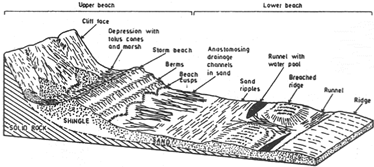
Spits and Bars: The ridges, embankments or mounds of sands formed by sedimentation through sea waves parallel to the shoreline are called bars. The larger forms of bars are called barriers. If the bars are formed parallel to the coast but are not attached to the land, they are called offshore or longshore bars. If the sand bars are formed in such a way that their one end is attached to the land, they are called spits. When a bar connects the mainland or head land with an island, it is called Tombolo. The given figure shows different types of hooks and Tombolo:
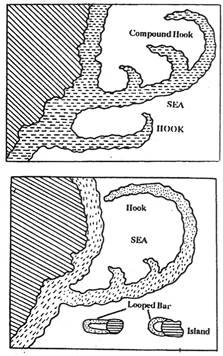
Q8. Provide a critique of the ‘geographical cycle’ model propounded by Davis. (2002)
Answer:
‘No vestige of a begining; no prospect of an end’ and present is the key to the past, were few dictums which were debated before Davisian model of geographical cycle, came into existence in 1899. This model is based on the basic concept of sequential change in landform through time like the evolution of an organic life.
Davis has assumed two forces affecting the land surface:
(i)Endogenetic
(ii)Exogenetic
- Endogentic forces create vertical irregularties by forming relief features of different dimension, whereas exogenetic processes originating from the atmosphere try to remove the vertical irregularities and the end product will be featureless peneplain. This whole process of creation and destruction is called ‘cycle of erosion’.
- Geographical cycle is the period of time during which an uplifted landareas undergoes its transformation by the process of land sculpture ending into a low featureless plain—a “Peneplane.”
- This concept of cycle is a matter of huge criticism because it is confusing, thus untenable. The landform evolution is not cyclic, it can be polycyclic, monocyclic, noncyclic also. At best, there are sequential changes, not cyclic changes. And also, because of various forces operating on them at a time, the likelyhood of completion of a cycle is very less.
- According to Davis’s three factors— (i) Structure (ii) Process (iii) Time-play important roles in the origin and development of landforms of a particular place. He postulated—landscape is a function of structure, process and time. Structure means lithological characteristics of rocks. Time was not used only in temperal context but also as a process itself. Process means the agents of denudation including both weathering and erosion.
- He assumed that there is a short period with rapid rate of upliftment in landmass. Erosion donot start until the upliftment is complete. Thus, upliftment and erosion donot go together.
- The cycle of erosion begins with the upliftment of landmass. There is aof short period of upliftment of landmass of homogenous structure. This phase of upliftment is not included in the cyclic time as this phase is infact, the preparatory stage of cycle of erosion.
- In the youthful stage, the summits are not affected by erosion because the rivers are small and widely spaced. The process of stream lengthening, pothole drilling, valley deepening take place in this stage. Slopes of convex plane emerged. The lower curve falls rapidly because of valley deepening but the upper curve remains almost parallel to the horizontal axis. Thus, relative relief increases and at the end of youthful stage ultimate maximum relief is attained.
- In the mature stage, lateral erosion starts and integrated drainage pattern evolves. Vertical erosion slows down, summits of water divide are also eroded and hence marked lowering of the upper curve. The V-shaped valleys turn into rectilinear valley.
- In the old stage, total absence of valley incision is witnessed but lateral erosion and valley widening continues. Water divides are more rapidly eroded. Thus, upper curves fall rapidly, which indicate a rapid fall in the absolute height. Low channel gradient, reduced kinetic energy and maximum entropy are other features of this stage. Concave valley side slopes, extensive floodplains, residual convexo-concave monadrocks make the surface peneplain.
- The duration of this stage is much protracted in time. This is how, the cycle is completed and the flat surface will again be affected by the vertical forces.
- Davisian model of geographical cycle is highly simplistic, based on certain assumption. These assumptious like flat surface, sudden uplift, erosion starts only after uplift stops, the concept of stages, the trio of stage, structure and process etc. are highly fallacious.
- Davisian concept of upliftment is not acceptable. He visualises rapid rate of upliftment of short duration, but as evidenced by plate tectonics, upliftment is exceedingly a slow and long continued process.
- His concept of relationship between upliftment and erosion is erroneous. Can erosion wait for the completion of upliftment?
- His model requires a long period of a crustal stability for the completion of cycle of erosion but such eventless long period is tectonically not possible as is evidenced by plate tectonics according to which plate are always in motion and the crust is very often affected by tectonic events.
- Walther Panek objected to over emphasis of time in Davision’s model. In fact, davision model envisages “Time Development Series” of landform development. According to Penek,landforms do not experience progressive and sequential changes through time and geomorphic forms are expressions of the phase and rate of upliftment in relation to the rate of degradation.
- Geographer’s like Strawla, Hack, Chorley have rejected the Davisian concept of historical evolution of landforms. They have farwarded the dynamic equillibrium theory for the explaination of landform development. It may be pointed out that non-cyclic concept of dynamic equillibrium as valid substitute of Davision cyclic concept of landform development is also highly debatable.
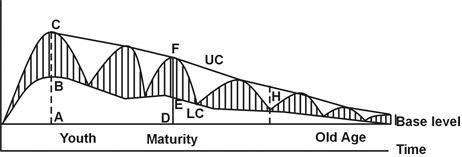
Q9. With reference to the theory of Plate Tectonics, explainthe origin and growth of the Young Fold Mountain Systems of the world. (2000)
Answer:
Plate Tectonics is the most comprehensive and systematic theory which provides for the best and the most rational explanation for the distribution of oceans and continents, ridges and trenches and organic zones and the various process leading to these. According to this theory, the upper portion of the lithosphere is believed to consist of a mosaic of rigid plates, with an estimated average depth of about 100 Km. These plates are embedded in a somewhat plastic layer of undetermind extent called the asthenosphere.
The plates vary considerably in the aerial expent. Some appears to be almost hemispheric in size, whereas others are much smaller size major plates and perhaps an equal numbers of smaller ones are postulated. Most of the plates consist of continental and oceanic crust. They move very slowly over the asthenosphere, the movements frequently bringing two plates together on a collision course. Such collision occurs along three types of plate boundaries:
- Constructive or divergent boundary – Here two plates move apart which is normally represented by an oceanic ridge.
- Destructive or convergent boundary :- Plates moving in opposite direction collide along this boundary.
- Trans current boundary – Here two plates just slide past each other.
Orogenetic Force: The orogenetic force to form mountains is provided by the compressive forces caused by the collision of two convergent plates, along the destructive plate boundary. Here the colliding plates provide for the compressional stress to fold, fault metamorphose, thrust and uplift the thick sedimentary accumulation along the continental margins; while melting of the subducted oceanic plate provides a source of magma that intrudes and extrudes, further deforming and metamorphosing these deposits. Thermal convective currents originating in the mantle have been accepted as the predominant force for the movement of plates.
The characteristics of mountain belts and the sequence of events vary depending on the type of plate interaction, and rock sequence involved in the deformation. There are three types of converging plate boundary interaction.
- Convergence of the oceanic plates
- Convergence of oceanic and continental plates
- Convergence of two continental plates.
We can analyse origin and growth of young fold mountain system of the world along these three convergent boundaries as per the theory of plate tectonics.
1. Convergence of two oceanic plates (Orogenetic at island) are:
Where two oceanic plates converge, one plate which is heavier is subducted beneath the other plate. This results in the formation of the fold mountain ranges of island arcs and festoons. Simple oceanic–oceanic orogeny is restricted largly to volcanic activity and does not involve widespread metamorphism. An example is the Tongan island arc in south pacific.
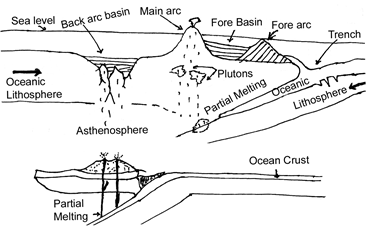
Complex oceanic to oceanic orogenesis involves crustal deformation metamorphism and granitic intrusion as well as volcanic activity producing a complex island arc. The best example is the Japanese island arc system.
2. Convergence of continental and Oceanic plates (Orogenesis at continental margin; cordillerian type):
The major events in this type of Fold mountain–building process can be analysed as:
- In this situation two plates having continental and oceanic margin along their edges respectively collide.
- The plate having heavier and denser oceanic crust along its margin is subducted beneath the other plate of lighter continental lithosphere.
- As the convergence proceeds, sediments and topographical features upon the oceanic crust is scrapped and accumulated at the continental margin, thus thickening the sequence of sediments.
- Then the thick sequence of geoclinal sediment along the continental margins are compressed and deformed to form cordillerian type of fold mountion.
- Partial melting of the descending slab generates silica rich andesitic magma which either rises to form grinitic intrusion in the deformed sedimantal crust or is entruded as volcanic material on the surface.
- High topography is thus produced in which granitic intrusion, metamorphism and volcanism is common.
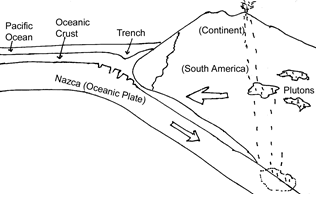
A good example of this type of fold mountain system is the Andes mountain which was formed by the collision of oceanic plate of Nazca and continental plate of South America. Rocky mountains of North America is another example.
Convergence of two continental plates (Himalayan type):
Here two continental plates collide in which main occurrences are:
- Geoclinal sediments occur along the margins of each continment
- As the continents move towards each other before colliding, the oceanic crust is cought in between and deformed and squeezed between the converging plates.
- When the continental parts collide, continental material being of low density, the force of buoyancy prevents any of the continental plate from subducting into the mantle.
- One of the continental crust is then thrusted under the overriding plate.
- A double layer of continental crust is produced resulting into growth of abnormally high topography.
- Since there is no subduction going on, volcanic activity and deep focus earthquake cease.
These major events are shown by the figure given below:
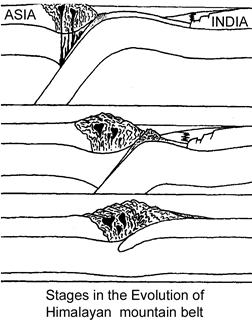
The himalayas, the Alps, and the Atlas mountains were formed 100 million years ago when the Deccan shield (Gondwana land) moved northward and collided with the Eurasian plate. Himalaya along with the double layer of Tibetan highlands is the best example where both the plates have been welded together along the Indus –Tsangpo suture zone.
Q10. Bring out the distinctions between the continental drift theory and the plate Tectonics theory. (1999)
Answer:
The most comprehensive and synthetic theory of Plate Tectonics which provides most rational explanation for many geologic and geomorphic phenomena, has evolved in a long process involving many researches, ideas and hypothesize the genesis of which can be rightly traced back to the theory of continental drift. The idea of continental movement relative to each other, originally suggested by Antonio Snider and later enriched by F.B. Taylor, was developed by German meteorologist Alfred Wegener, into a full scale hypothesises in order to explain the climatic changes of the past. The hypothesis was heavily criticised at that time but it was the first great endeavour to scientifically explain the arrangement of continents and ocean basins and other problems which stirred the scientific community and initiated a kind of scientific inquiry that led to the development of plate tectonics theory in due course.
The expanded version of Wegener’s idea was published in his book ‘The origin of continents and oceans’ in 1915 in which heHypothesized.
- The existence of a supercontinent named Pangea (meaning all land) surrounded by ocean called Panthalsa during carboniferous period (about 300 million years ago). South Pole was located near Natal and North Pole in Pacific ocean.
- The Pangea started breaking into smaller continents during Mesozoic times (200 m.y. ago). The Northern part called Angaraland and southern part called Gondwanaland were separated by a geosyncline called Tethys
- The larger and sturdier continents made of Sial actually broke through the oceanic crust of Sima much like the ice-breaker cut through ice and started drifting in two directions.
- The northward movement towards equator was caused by gravitational attraction (exerted by equatorial bulge) and force of buoyancy which pushed Africa, Indian peninsula and Eurasia close together, buckling and raising the in-between Tethys sea deposits to form Alps, Atlas and Himalayas.
- Westward movement due to tidal force of the moon and the sun separated North America and South America from Europe and Africa respectively.
In this way continents drifted to their present position which has been depicted in the schematic figure given below:
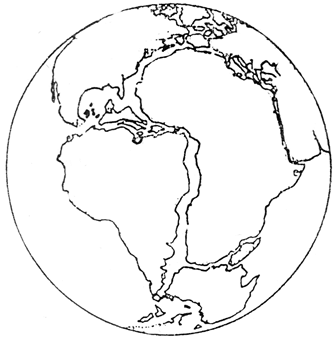
Evidences:
1. Fit of Continents: The opposing coasts of Atlantic are very much similar in shape and if drawn together they make as Wegener calls it a Zigsaw-fit. But opponents criticised it rightly that shorelines are continually modified by endogenetic and exogenetic forces.
2. Paleontological Evidence: Fossils of glosopteris, a fern, belonging to mesozoic period have been found in South America, Africa, Australia, India and Antarctica. This and fossils of other land animals present a strong supportive evidence of a unified Pangea. But this was countered by critics arguing that there might have been parallel evolution of organisms on different continents.
3. Rock Type and Structural Similarities: Wegener made a good correlation between rocks found in N.W. Africa and Eastern Brazil. In both regions 550 m.y. old rocks lie adjacent to rocks dated 2 billion years in such a manner that the line separating are brought together. Likewise mountains similar to Appalachians is continuous when the continents in age and structure reappear at the coast of Ireland and Brittany.
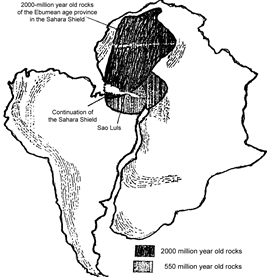
4. Paleoclimatic Evidence: Vast amount of glacial hill belonging to early mesozoic and late paleozoic era (220 – 300 m.y.) have been found in present day tropical areas of South America, S. Africa, India and Australia. Wegener rejected the idea of cold age existing at that time because coal deposits of almost same period are found in the Northern Hemisphere. This could be explained only by moving Pangea near to the South Pole.
Despite such evidence, most scientists felt that three difficulties made the theory improbable if not impossible:
- Lack of sound driving mechanism for continental movement. It was calculated by Jeffreys that the magnitude of tidal force needed for the drift would halt the earth’s rotation itself.
- Oceanic crust is too rigid to allow sturdier continent to break through it.
- There is seeming paradox involved in the assumption of sial masses drifting through the sima which at the same time is supposed to have sufficient strength to buckle their advancing edges.
During 1950’s and 60’s, the idea of continental movement was revived, though widely modified, with new scientific discoveries.
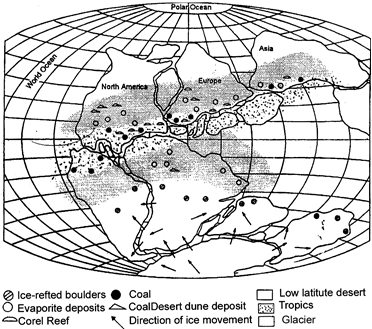
Paleomagnetism: When magma cools and solidify into rock, it becomes magnetised in the direction of magnetic North and South of the Earth. Studies during 50’s found rocks of different ages having different magnetic alignment which indicated either polar wandering or continental displacement. But polar wandering curves drawn for North America and Europe were surprisingly, found to be separated by 30º longitude. There can not be two poles so continents must have moved.
Plate Tectonics: Similarly, several dramatic discoveries and recent researches in the fields of paleomagnetism, Marine Geology; Sea Floor spreading, Geomagnetic Reversal, earth’s internal structure etc. led to the resurrection of old idea of Wegener’s continental drift, albeit in a complete different form in the much more encompassing and unified theory of Plate Tectonics. This revolutionary theory of late 60’s and 70’s updated by the later developments in science and technology provides the best available and most logical explanation for the distribution of oceans and continents, ridges and trenches, organic, volcanic and seismic zones and various processes leading to these Wegener’s theory was inadequate and lacking in these respects. The plate tectonics theory states that Earth’s lithosphere which consists of rigid upper part of upper mantle plus oceanic and continental crust, in broken into a mosaic of rigid segments called plates that slides on the underlying hot and plastic asthenosphere. These plates may be oceanic or continental or both, a major departure from the continental drift theory.
For a plate to be identified all the boundaries mush have witnessed present or recent activity in terms of seismicity.
As plates are in constant motion relative to each other, almost all tectonic activity occurs along the plate boundaries. Three types of plate boundaries are identified which define three fundamental kinds of deformation, tectonic and geological activity:
I. Diverging Boundary:
- Also called spreading/constructive boundaries where two plates move away from each other.
- Most of these are located upon the oceanic floor marked by the pressence of mid-oceanic ridges.
- Characterised by the rift valley system indicating that lithosphere is being torn apart.
- Volcanism is of the basaltic type resulting in the formation of new crust.
- These boundaries experience rising limb of convection current.
- Occurrence of shallow foci earthquakes.
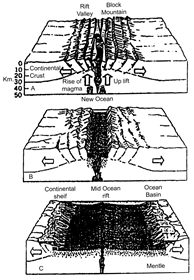
II. Converging Boundary:
Here collision of two plates occur which can be of three types:
(a) Ocean-Ocean Collision: Where two plates having oceans at their margin collide, oceanic plate having higher density descends into the asthenosphere (called subduction) where it gets melted and thrown upwards resulting in the formation of volcanic island arc system e.g. Japanese island arc due to subduction of Pacific plate under Eurasian plate.
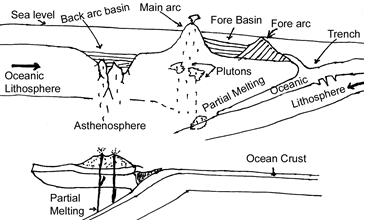
(b) Ocean-Continent Collision: Here denser Oceanic plate subducts and the thick layer of rocks along the continental margin along with scrapped off sediments of oceanic plate are deformed to form a cordillera type mountains like Andes. Like the ocean-ocean collision here also andesitic and granitic volcanism and deep focus earthquakes occur.
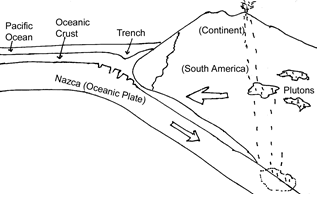
(c) Continent Collision: There is no subduction due to low density of continental material, hence volcanism ceases now. Continued convergence results in under thrusting such as Indian plate has under-thrusted beneath Eurasian landmass, creating a thick layer, supporting the high elavation of Tibetan Plateau. In the process, vast sediment of Tethys has crumpled to form mighty Himalayas. Here high magnitude earthquakes frequently occur due to continued collision of plates.
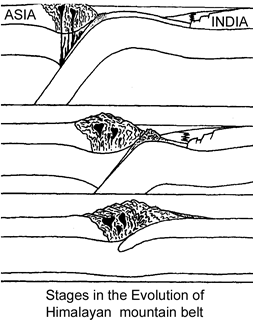
III. Conservative Boundary:
Here the plates just slide past each other without creating or destroying crustal matter, hence no scope for volcanism. Shallow foci earthquakes occur here, e.g. San Andreas fault.
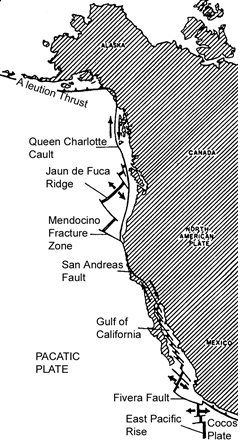
In this way Plate Tectonics theory is a marked improvement over continental drift theory in explaining these geologic and geomorphic features. Plate Tectonics has conclusive evidence of plate movement as vindicated by polar wandering curves, Geomagnetic reversals, marine geological researches, seismological evidences and later on by satellite based techniques such as Satellite Laser Ranging (SLR) etc. Plate Tectonics has also rectified many incorrect details of Wegener’s theory such as sial moving over sima. Wegener failed to provide a sound driving mechanism whereas many driving mechanisms have been suggested for plate movement such as convection current, push-pull model, gravity sliding, hot spot model. Though the Plate Tectonics is also criticised for having incomplete understanding of driving mechanism, thermal evergy generated by convection current in the mantle is the most accepted explanation.
Q11. Discuss the concept of volcanicity and show how the theory of plate tectonics explains the mechanism of volcanism and volcanic eruption. (1998)
Answer:
Volcanism includes all phenomena connected with the movement of treated material from the interior towards surface of the earth. In other words, volcanicity includes all those processes and mechanisms which are related to the origin of magmas, gases and vapour, their ascent and appearance on the earth surface in various forms.
Now it becomes clear that volcanicity has two components:
- The endogenetic mechanism of volcanicity includes the creation of hot and liquid magmas and gases in the mantle and the crust their expansion and upward ascent, their intrusion, cooling and solidification in various forms below the crustal surface.
- The exogenatic mechanism includes the process of appearance of lava, volcanic dust, and ashes, fragmental material mud, smoke etc. in different forms.
Basically there are three major processes embrassed by volcanic activity.
- Creation of magma
- Ascent and intrusion of magma
- Extrusion of molten material on the surface by simple and quiet activity or by forceful ejection through explosive volcanic activity.
Though volcanic activity endangers the life forms on the earth surprisingly it is volcanicity which is responsible for the creation of hydrosphere and atmosphere. Thus volcanicity has also been responsible for the evolution of life forms on the earth.
Origin of Magma: Creation of magma within the earth is the result of complex interaction between temperature, pressure and matter which is being discussed as follows:
- Increase in Heat: Melting of magma requires high thermal energy which is supplied by radioactive elements which disintegrate and release heat energy. Energy is also provided by earthquake’s upward convection current from the mantle and frictional heating.
- Decrease in Pressure: With the increase in depth in the earth interior there is both increase of temperature and pressure. This increasing pressure raises the melting point of the rocks, so that the melting point of the rocks may be raised above the prevailing temperature. Since the melting point of the rocks increases with load pressure, a decrease in pressure, perhaps by faulting would reduce the effective melting point at a given depth resulting in melting of the rock.
- Water: Water increases the melting point of most silicates. However the role of water is variable in the generation of magma.
This understanding of magma generation is very helpful in understanding the causes, distribution and types of volcanic activity through the theory of plate-tectonics.
Plate Tectonics and Volcanism: The revolutionary theory of plate-tectonics well explains the mechanism of volcanism and volcanic eruptions. The theory of plate-tectonics envisages that earth’s lithosphere consists of a mozaic of lithospheric blocks, as above over the underlying layer of plastic asthenosphere. This movement of plates result in three types of plate boundaries. According to plate-tectonics there are two types of volcanic activities:
(i)Plate boundary volcanism
(ii)Intra-plate volcanism
(i)Plate Boundary Volcanism: Among the three types of plate boundary, volcanic activity takes place along the two boundary types only-
(a)Constructive Boundary Volcanism: Along this boundary as the plate break and move apart along a fissure or fault the asthenosphere also move upward along the fault and the spreading zone and the disturbance of pressure, temperature, equilibrium caused by decrease in pressure cause partial melting of peridotite to yield basaltic magma. Here the magma eruption occurs in a very quiet manner. Such type of quiet volcanic activity takes place along the mid oceanic ridges.
(b)Destructive Boundary Volcanism: When two plates collide the oceanic crust being heavier plunges into the mantle in the subduction process. This subducted crust gets heated by the high temperature in the depth and melts. This melting results into creation of andesitic magma which rises upward because of low density resulting into explosive volcanic activity. Hence volcanic activity at the convergent boundary is of explosive type. This types of volcanism is found in the famous pacific ring of fire.
But, where two plates having continental margin collide neither plate subducts. So there is no volcanism in such collision, for example in the Himalayan belt, there is no evidence of volcanic activity.
(ii) Intra-Plate Volcanism: This is related to activity of the hot spots. These hot spots are fixed places on the surface of the Globe which yields flood basaltic eruption. These hot spots may be located on the continent or on the ocean floor. The intra plate volcanism is always of basaltic nature. The deccan lava eruption is a typical example of intra plate volcanic activity. However the best examples are Hawaiian-Emperor-Seamount chain in the pacific ocean. Best known examples of continental intra plate volcanism are the African rift system and Rehine Graben.
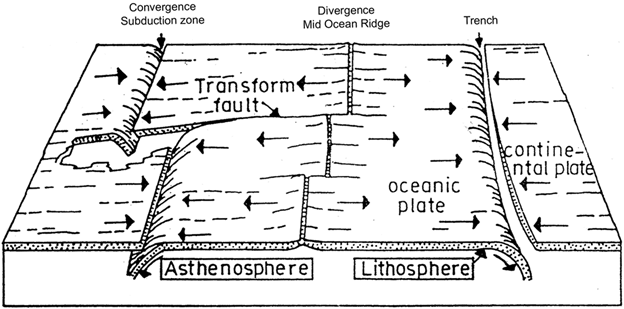
Q12. Discuss the process of mechanical and chemical weathering and show their relationship with soil formation. (1996)
Answer:
Weathering has been defined as the total of all processes acting at or near the earth’s surface to cause physical disruption and chemical decomposition of rocks in situ. Weathering by itself is a static process and does not involve removal of material. In other words, weathering is the process by which rocks are broken down and decomposed by the action of external agencies such as wind, rain, temperature changes, plates, bacteria, etc. Thus weathering is essentially the breakdown of rocks due to chemical and mechanical processes at their places.
- Rocks are disintegrated and decomposed and ultimately are broken down into smaller pieces due to the operation of different weathering processes, e.g. physical weathering, chemical weathering and biochemical weathering. These different weathering processes produce immense volumeof rock waste or weathered materials. These weathered materials lying over the unweathered fresh rocks are called regoliths. These weathered materials are very important economically because they help in the process of soil formation.
- Soil is the upper weathered layer of the earth’s crust. It is a dynamic entity which is always undergoing physical, chemical and biological changes. Weathering contributes both in the formation of soils, and physical and chemical changes occurring in the soil.
- Soil is made up of substances existing in three states-solid, liquid and gases. The major part of the solid portion of soil is inorganic matter. Weathering of the rocks produces inorganic particles that give a soil the main part of its weight and volume. These fragments range from gravel and sand down to tiny colloidal particles.
- Generally, weathering processes are broadly divided into mechanical and chemical processes as discussed below:
A.Mechanical (Physical) Weathering: Mechanical weathering is the breakdown of rocks into smaller fragments by various physical stresses without any chemical alteration. This is brought about mainly by the changes in temperature, frost action, salt crystal growth, pressure release, wind action, moisture swelling and biological stresses. The various processes of mechanical weathering are as follows:
I.Thermal Changes
(i)Block Disintegration due to temperature change: Rocks are characterized by poor thermal conductivity. When rock surfaces are heated by sun, the rocks expand rapidly. Cooling either by radiation or rain causes it to contract. Thus the repetition of expansion and contraction of outer rock layers especially in dry cloudless regions (hot and cold deserts) having marked diurnal range of temperature introduces parallel joints in the rocks along which rocks are disintegrated blockwise. This is the initial step in the further disintegration of rock which can lead to soil formation.
(ii)Granular Disintegration due to temperature change: Since most rocks are composed of several minerals with different co-efficient of expansion, repeated heating and cooling in arid regions causes inter mineral stresses resulting in granular disintegration of rocks, especially in coarse grained rocks. This process contributes significantly in soil formation by providing mineral matter to it.
(iii)Exfoliation: It refers to peeling off concentric shells of rocks due to combined action of heat and wind in hot tropical regions. It is more common over crystalline rocks.
II.Frost Weathering: The repeated expansion of water of freezing in pores or cracks of rocks and melting of ice crystals in rock fractures and pore spaces of soil disintegrates even the hardest rocks like granite. Predominantly found in cold climates, this process leads to block separation of rocks, there by facilitating further disintegration of these blocks to help in the soil formation.
III.Salt Crystal Growth: Evaporation of the water drawn to the surface of the rock by capillary force leaves behind tiny crystals of salt such as halite, calcite or gypsum. The growth force of these crystals produces grain-by-grain breakup of the sandstone which crumbles into a sand. This weathered matter provides the base material for the formation of soil in due course.
IV.Pressure Release: The removal of superincumbent load or unloading,effected through gradual erosion of over lying rocks releases the confining pressure and the rocks expand, leading to development of fractures in the newly exposed rock. Ultimately, rocks break up along these cracks and joints.
V.Moisture Swelling : Some rocks such as those with a high clay content expand slightly when wet and contract again when dry. Repetition of such pressure causes fracturing to occur in the material.
VI.Biological Stresses: Biological stresses too induce physical weathering which can occur in two ways:
(a)Floral root tension
(b)Faunal activity (especially burrowing organisms).
B.Chemical Weathering: Decomposition and disintegration of rocks due to chemical reactions is called chemical weathering. Water vapour and water, especially rain water are the media which activate several types of chemical reactions within the rocks. The rate of chemical weathering varies greatly between different regions but is most pronounced in hot humid regions. The important chemical weathering processes are:
I.Solution: It is the first step in the chemical decomposition of rocks. Solution refers to the dissolution of soluble particles and minerals from the rocks with the help of water. Common salts are most soluble while carbonate rocks are of moderate solubility. This process of solution imparts many important minerals such as bicarbonates and salts to the soil.
II.Oxidation/Reduction: Oxidation/Reduction is addition or removal of oxygen. Most rocks contain iron bearing minerals so oxidation process results into formation of iron oxides. The oxidation of iron bearing rocks produces rusting in the rocks.This rusting weakens the rocks and ultimately the rocks are disintegrated. The iron oxides constitute an important mineral content of the soil.
III.Carbonation: Carbonation is the process whereby carbon dioxide is introduced into a fluid. This changes any rock mineral that contains lime, soda, etc. into bicarbonate.
IV.Hydration: Hydration occurs when minerals incorporate water into their molecular structure. It causes swelling and is believed to be a major cause of the crumbling of coarse grained igneous rocks. This process may form new compounds and thus helps in formation and chemical alteration of soils.
V.Hydrolysis: Hydrolysis refers to chemical union of water and mineral. The process involves specific chemical change in which new mineral compound is formed. This happens when hydrogen ions from ionised water replace potassium, calcium, magnesium or sodium ions in mineral combinations. Silicate minerals are most affected by hydrolysis. In granite the feldspars disintegrate as a result of the chemical action of water and decompose into insoluble mineral such as kaolin. The net result is a fine residual, quartz sand and other unweathered minerals.
IV. Chelation: Chelation occurs because plant roots are surrounded by a concentration of hydrogen ions which can exchange with the cations in adjacent minerals. Plants extract minerals from the soils with the result mineral lattices are disrupted and crystal lattices are fragmented, resulting into faster rate of mineral weathering.
All these chemical weathering processes come under the process of transformation of material in the soil forming process which involves decomposition of primary minerals into secondary minerals and formation of new minerals in the soil.
Q13. Discuss the limitations of the theory of Continental Drift and show how the theory of Plate Tectonics is an improvement over it. (1995)
Answer:
The modern theory of Plate Tectonics which provides most rational explanation for many geologic and geomorphic phenomena has evolved in a long process involving many researches, ideas and hypothesises the full scale genesis of which can be rightly traced back to the theory of Continental Drift. This view of non- stationary continents, first suggested by Antonio Snider and later enriched by F.B. Taylor,was developed by German meteorologist Alfred Wegener into a full-scale hypothesis.
In his theory of continental Drift, Wegener hypothesized the following:
- The existence of a supercontinent named Pangea surrounded by a ocean called Panthalsa during carboniferous period.
- The Pangea started breaking up into smaller continents during carboniferous period.
- The larger and sturdier continents made of sial actually broke through the oceanic crust of sima much like the ice-breaker cut through the ice and started drifting in two directions.
- The northward movement towards equator was caused by gravitational attraction caused by equatorial bulge while the westward movement due to tidal force of the moon and the sun separated Americas from Europe and South Africa.
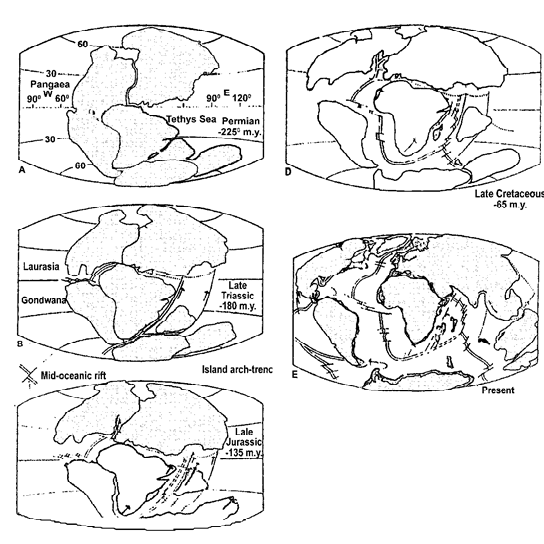
In this way continents drifted to their present position as shown in the given figure here:
Though the Wegener’s theory was the first great endeavour to explain scientifically the arrangement of continents and ocean basins and other problems but the theory was constrained by various limitations and was severely criticized by the scientists at that time. The limitations of his theory can be discussed in the following way:
I.Though Wegener provided many evidences to support his view of continental movement, he could not furnish conclusive evidence of continental drift. His evidences are the following:
- Fit of the continental coasts now widely separated.
- Paleontological evidence.
- Rock type and structural similarities between continents.
- Paleoclimatic evidence.
As regards fit of the coasts, opponents criticized that shorelines are continually modified by endogenetic and exogenetic forces. Further, there might have been parallel evolution of organisms on different continents. Paleoclimatic evidence (evidence of glacial till and coal deposits of mesozoic period) was a strong evidence but it could not conclusively prove the continental drift.
II.The theory suffers from lack of sound driving mechanism for continental movement. It was calculated by Jeffreys that the magnitude of tidal force needed for the drift would halt the earth’s rotation itself.
III.Oceanic crust is too rigid to allow sturdier continent to break through it.
IV.There is seeming paradox involved in the assumption of sial masses drifting through the sima whichat the same time was suggested (by Wegener) to have sufficient strength to buckle their advancing edges.
V.Thus the theory of continental drift was unable to explain satisfactorily the origin and distribution of mountains, earthquakes, vulcanism and related processes.
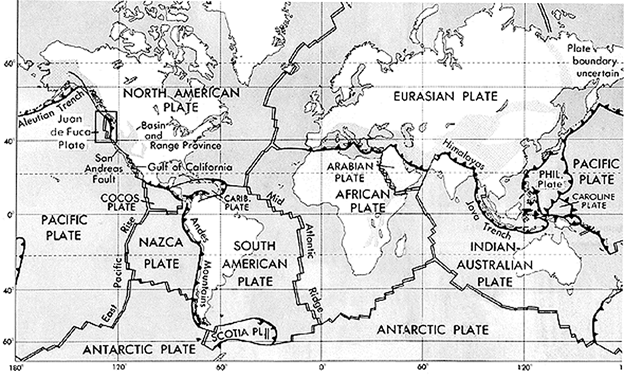
However, continental drift theory was a great endeavour of its time which stirred the scientific community and initiated a kind of scientific enquiry that led to the development of Plate Tectonics Theory in due course. Later on, several dramatic discoveries and recent researches in the fields of Paleomagnetism, Marine Geology, Sea Floor Spreading, Geomagnetic Reversals, earth’s internal structure etc. led to the resurrection of the old idea of Wegener’s continental drift, albeit in a different and improved form in much more comprehensive & unified theory of Plate Tectonics.
The Plate Tectonics Theory states that Earth’s lithosphere (crust + rigid upper part of upper mantle) is broken into a mosaic of rigid segments called plates that slide on the underlying hot and plastic asthenosphere. These plates may be oceanic or continental or both—a major departure from continental drift theory.
For a plate to be identified all the boundaries must have witnessed present or recent activity in terms of seismicity:
As plates are in constant motion relative to each other, almost all tectonic activities occur along the plate boundaries. Three types of plate boundaries are identified:
I.Diverging Boundary
- Also called spreading/constructive boundary where two plates move away from each other.
- Most of these are located upon the oceanic floor marked by the presence of oceanic ridges.
- Characterised by the rift valley system.
- Volcanism is of basaltic type resulting in the formation of new crust.
- These boundaries experience rising limb of convection current.
- Shallow foci earthquakes occur here.
II.Converging Boundary: Here collision of two plates which can be of three types:
(a)Ocean-Ocean Collision: Where two plateshaving oceans at their margins collide, oceanic plate having higher density descends into the asthenosphere called subduction where it gets melted and thrownupwards resulting in the formation of volcanic island arc system, e.g. Japanese island arc due to subduction of Pacific plate under Eurasian plate.
(b)Ocean-Continent Collision: Here denser oceanic plate subducts and the thick layer of rocks along the continental margin are deformed to form a cordillera type mountains, e.g. Andes and Rockies. Like the ocean-ocean collision here also anderitic and granitic volcanism and deep focus earthquakes occur.
(c)Continent-Continent Collision: There is no subduction now due to low density of continental material, hence volcanism ceases here. Continued convergence results in under-thrusting such as Indian plate has under thrusted beneath Eurasian landmass, creating a double layer, responsible for the high elevation of Tibetan Plateau. In the process, vast sediment of Tethys has crumpled to form mighty Himalayas. Here high magnitude earthquakes frequently occur due to continued collision of plates.
III.Conservative Boundary: Here the plates just slide part each other without creating or destroying crustal matter, hence no scope for volcanism. High intensity earthquakes do occur here e.g. around San Andreas Fault.
- In this way Plate Tectonics theory is a marked improvement over Continental Drift Theory in explaining there geologic and geomorphic features. Plate Tectonics has conclusive evidence of plate movement as vindicated by polar wandering curves, geomagnetic reversals, marine geological researches (Sea Floor Spreading etc.) Seismological evidences and later on by Satellite Laser Ranging technique, etc. Plate Tectonics has also rectified many incorrect details of Wegener’s theory such as sial moving over sima. Wegener failed to provide a sound driving mechanism whereas thermal energy generated by convection current in the mantle is the most accepted explanation for plate movement.
- Wegener’s Theory incorrectly tries to explain mountain building processes and their distribution. Plate Tectonics satisfactorily explains origin and distribution of mountains due to collision of plates (e.g. island arcs, Rockies. Andes, Himalaya – Alps). Plate Tectonics has also been able to explain some old mountains e.g. Ural and Appalachian. In explaining vulcanism and earthquakes, Plate Tectonics is miles ahead of Continental Drift theory, as has been discussed above in plate boundary interactions.
In case you still have your doubts, contact us on 9811333901.
For UPSC Prelims Resources, Click here
For Daily Updates and Study Material:
Join our Telegram Channel – Edukemy for IAS
- 1. Learn through Videos – here
- 2. Be Exam Ready by Practicing Daily MCQs – here
- 3. Daily Newsletter – Get all your Current Affairs Covered – here
- 4. Mains Answer Writing Practice – here
